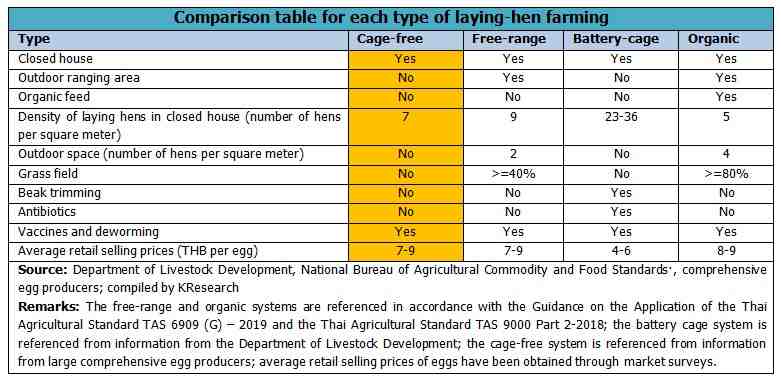Animal welfare is becoming a widely discussed topic in the food industry. Eggs produced by cage-free laying-hens, also known as “cage-free eggs”, are one of the products for which the Department of Livestock Development is preparing to set standards for certification, in addition to other production standards, in order to provide more choices of product quality for consumers. In the meantime, there will also be guidelines for the raising of production standards for Thai livestock products, in line with the trend of being more aware of animal welfare in consumption. Currently, the department is in the process of drafting standards for laying-hen farming in enclosed systems (cage-free).

KResearch views that cage-free eggs are becoming more and more popular among consumers who care about their health as well as about safe and socially responsible product sourcing, and who are willing to pay higher prices. From a global perspective, it can be seen that locations with a high per capita consumption of eggs, such as the European Union and the United States, have enacted laws prohibiting battery-cage farming for laying-hens, mainly due to consideration of animal welfare, as well as the fact that the battery-cage system has a higher impact on the quality of eggs and chance of contamination from the farming system than other methods. Therefore, the quantity of eggs produced by the battery-cage system may decline, while a growth in quantity of eggs produced by other farming systems that take animal welfare into consideration, namely organic eggs, free-range eggs and cage-free eggs, will be led by consumer-driven demand. It is estimated that the total value of the world's cage-free egg market in 2019 was USD4.98 million, and the average annual growth rate is expected to be 4.75% from 2020 to 2025.
Although cage-free eggs have been present on Thailand’s market for a while, they are positioned as alternative products in the premium egg segment targeting the domestic high-end consumer market [1]. The main producers are large-scale integrated egg producers, but there is no domestic production certification to foster consumer confidence. Most foreign cage-free egg certifications, which are internationally recognized, clearly specify production guidelines, such as the density of laying-hens per unit area (for example, 1.25 square feet per hen under the regulation of the American Humane Association, 1.00 square foot per hen under the regulation of United Egg Producers Certified).
Therefore, if standards for the certification of cage-free laying-hen farming are officially promoted and implemented, besides the positive impact on consumers, they will also have a positive impact from a business perspective on cage-free egg producers as well as on modern farmers because clear standards will help improve product credibility. It is expected that egg producers targeting high-end consumers will tend to increase their production capacity. Although the production costs of such eggs are higher than those of eggs produced by the conventional closed-house system [2], their returns are also higher. In addition, this increase in returns may become another way to easily motivate egg producers to upgrade their laying-hen feeding system from a battery-cage system to a cage-free system that values animal welfare, because the transformation requires adjusting the density of laying-hens in closed houses and banning the use of antibiotics. Other feeding systems, such as organic or free-range farming, may require additional conditions such as
an improvement of the feed provided to hens and adjustment of outdoor ranging areas, causing relatively high costs. At present, non-battery-cage eggs account for around 10% of total egg production, but their proportion is expected to increase continuously.
Looking forward, the currently limited demand for cage-free eggs will expand to include retail businesses and food chain restaurant businesses, as well as downstream industry customers who will be more responsive to this type of product, such as instant food/processed food/ready meal businesses, premium restaurants, hospitals and hotels. These businesses put emphasis on responsible procurement policy, which helps to establish a positive image to consumers. In addition, cage-free eggs can also meet the needs of consumers who pay attention to high-quality health products and are potential customers, such as health-conscious people, exercisers, children/elderly people, medical patients and tourists.
[1] 96% of Thailand’s egg production is for domestic consumption while the remaining 4% is for export purpose.
[2] The average production cost of eggs in the closed-house system is THB2.56 per egg (Office of Agricultural Economics, 2019).